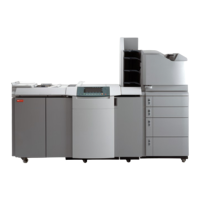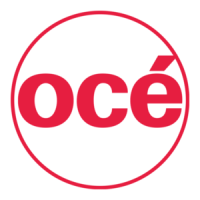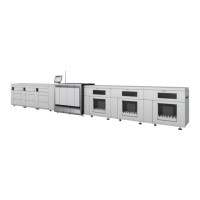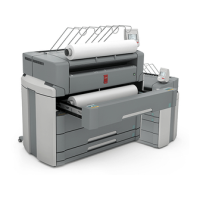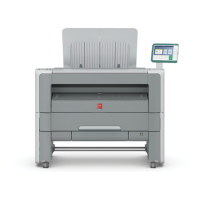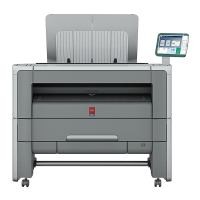Do you have a question about the Oce VarioPrint i Series and is the answer not in the manual?
| Print Technology | Inkjet |
|---|---|
| Connectivity | Ethernet |
| Ink Type | Pigment-based ink |
| Duplex Printing | Yes |
| Operating Systems | Windows |
Provides an overview of the VarioPrint i-series printers, their technology, and key software applications.
Provides crucial safety and environmental information for operating the printing system correctly and safely.
Explains the meaning of various warning and caution labels used on the machine to highlight hazards.
Defines the term "Ordinary person" in the context of safety information.
Overview of printer hardware components and their functions.
Explains the paper input process, sheet transfer, and module functions.
Details ink technology, printhead operation, and sheet drying process.
Describes print collection and ejection using high capacity stackers.
Factors influencing print quality: ink, media, and print process.
Overview of control panel, remote driver, manager, and editor for printer operation.
Description of control panel parts and their functions for printer operation.
Procedures for logging in, logging out, and managing passwords for printer access.
Ending printer sessions or switching user credentials to access functions.
Procedure for changing user passwords for printer access.
Steps to recover a lost password via email or control panel.
Interpreting printer status indicators, including colors on the dashboard and control panel.
Customizing control panel display, job name display, and warning notifications.
Setting default accessibility options for the printer.
Configuring default stacking parameters for output.
Importance of media in printing and related concepts.
Process of assigning media to trays.
Step-by-step guide for loading media.
Manual ejection of print stacks.
Workflow from preparation to delivery using IPDS.
Enabling transaction printing mode on control panel or Settings Editor.
Managing online/offline status via Settings Editor.
Managing jobs in PRISMAproduction, including stopping or aborting.
Creating, copying, editing, and deleting transaction setups.
Making a transaction setup active.
Modifying transaction setup attributes, particularly IPDS settings.
Detailed IPDS attribute configuration.
Checking media definitions for validity.
Understanding different workflow profiles for job management.
Selecting and adjusting workflow profiles to match requirements.
Workflow overview for document printing from submission to delivery.
Switching between transaction and document printing modes.
Using the schedule for job production time and management.
Understanding automated workflows for defining job properties.
Creating, copying, and editing automated workflows.
Configuring automated workflow attributes.
Applying automated workflows to jobs on the control panel.
Locating and managing jobs across different destinations.
Removing print jobs before or after printing.
Setting up variable data printing for personalized documents.
Detailed preview and CMYK adjustments using tone curve editor.
Modifying job name, number of sets, and print range.
Modifying media and print modes for a job.
Adjusting print layout, binding edge, and cover settings.
Adjusting print quality settings like color presets and resolution.
Configuring output tray, sorting method, and offset stacking.
Printing one or more jobs from the control panel.
Methods to stop or delay printing of jobs.
Stopping printing after a completed set or record.
Understanding media family calibration for stable color quality.
Step-by-step instructions for calibrating a media family.
Interpreting calibration feedback and measurement accuracy.
Tuning CMYK tone curves for optimal color reproduction on media.
Using the spectrophotometer for measurements.
Importance of printhead maintenance for image quality.
Procedure for repairing nozzle failures.
Evaluating color reproduction using validation tests.
Executing color validation tests and printing target charts.
Setting default color behaviors like black and white printing and image smoothing.
Reducing energy consumption by activating sleep mode.
Turning off the printer for extended periods.
Automating printer shutdown and wake-up cycles.
Replacing empty ink or liquid containers.
Replacing the CMYK ink waste container.
Replacing the ColorGrip waste container.
Replacing the waste water container.
Using remote assistance for support from the Service organization.
Steps to restart the printer to solve problems or implement adjustments.
Procedure for removing sheets stuck to printheads.
Procedure for removing sheets stuck on the fixation drum.
Correcting alignment deviations and printing verification charts.
Status indicators for supplies and waste.
